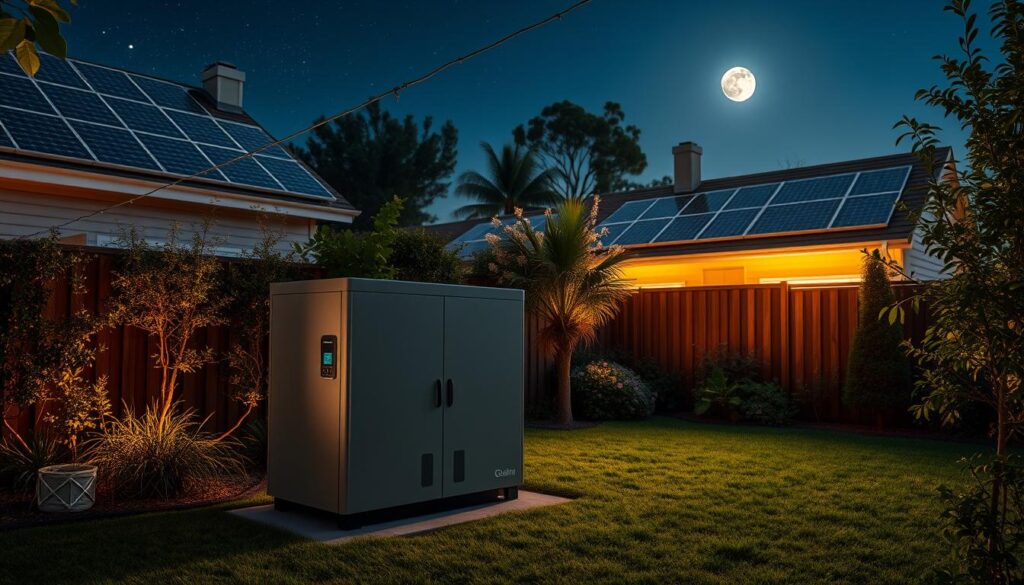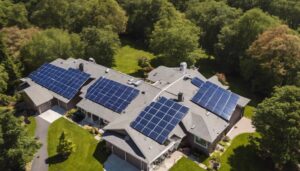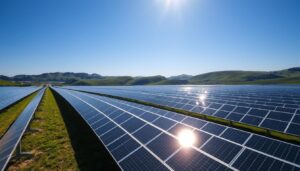According to Energy.gov.au, Australia has the highest uptake of solar globally, with more than 21% of homes with rooftop solar PV. As of May 2020, over 2.43 million rooftop solar power systems have been installed. Solar panels are made up of solar cells that convert light into direct current (DC) electricity. However, solar panels do not work at night as they require sunlight to generate power. At night, solar customers can use either solar battery storage or net metering to power their homes.
Key Takeaways
- Solar panels do not generate electricity at night due to the lack of sunlight.
- Solar customers can use battery storage or net metering to power their homes at night.
- Australia has the highest global uptake of solar power, with over 21% of homes having rooftop solar PV systems.
- As of May 2020, over 2.43 million rooftop solar power systems have been installed in Australia.
- Solar panels convert sunlight into direct current (DC) electricity during the day.
Understanding Solar Panels
Solar panels are remarkable devices that harness the power of the sun to generate clean, renewable electricity. These panels are made up of several smaller units called solar cells. These ingenious devices work by capturing sunlight and converting it into direct current (DC) electricity through the photovoltaic effect. However, a single solar panel can typically only generate enough power to run a few small appliances.
To power an entire home or building, an array of interconnected solar panels is required. The DC electricity generated by the solar panels is then converted to alternating current (AC) power, which is the type of electricity used in most households. This process of converting DC to AC is done through an inverter, a crucial component of any solar power system.
What are Solar Panels?
Solar panels are composed of photovoltaic cells, which are responsible for converting sunlight into electrical energy. These cells are typically made from silicon, a semi-conductive material that reacts with sunlight to generate an electric current. When sunlight strikes the solar cells, the photons in the light excite the electrons in the silicon, causing them to flow and generate a direct current (DC) electricity.
How Do Solar Panels Work?
The process of converting sunlight into electricity through solar panels is known as the photovoltaic effect. When sunlight strikes the solar cells, the photons in the light transfer their energy to the electrons in the silicon, knocking them loose from their atoms. These free electrons then flow through the material to produce direct current (DC) electricity.
The DC electricity generated by the solar panels is then fed into an inverter, which converts it to alternating current (AC) electricity. This AC electricity can then be used to power your home or be fed back into the electrical grid, depending on the setup of your solar power system.
The efficiency of solar panels is continuously improving, with researchers and engineers working to develop new technologies that can harness the sun’s energy more effectively. From flexible solar cells to advancements in battery storage, the future of solar panel technology and photovoltaic energy looks brighter than ever.
Solar Panel Performance on Cloudy Days
While solar panels are designed to harness the power of the sun, they can still function effectively even on cloudy days. However, their efficiency is reduced compared to clear, sunny conditions. On average, solar panels will produce about 25% of their rated output on a cloudy day. This is due to the fact that cloud cover blocks a significant portion of the sunlight from reaching the solar cells.
Despite the lower output, solar panels can still generate up to 50% of their peak capacity on a bright, sunny day with some cloud cover. The exact performance will depend on the thickness and density of the clouds. Thin, wispy clouds may only slightly diminish the solar panel’s efficiency, while thick, heavy clouds can have a more substantial impact.
The efficiency of solar panels can also be affected by temperature. As the surface temperature rises above 25°C (77°F), the panel’s output begins to decline. This is an important consideration, especially in hot climates where the temperature can significantly impact solar panel performance.
Despite the reduced efficiency on cloudy and hot days, solar panels can still be a viable option for homes in a variety of climates. With advancements in solar technology and the incorporation of battery storage systems, homeowners can optimize their solar energy use even when the weather is less than ideal.
| Condition | Solar Panel Output |
|---|---|
| Sunny Day | 100% of rated output |
| Cloudy Day | 25% of rated output |
| Bright, Sunny Day with Cloud Cover | Up to 50% of peak output |
| Hot Weather (Above 25°C/77°F) | Decreased efficiency |
“Solar cells exist that can produce a tenth of their day performance at night, and expensive solar cells used for satellites are highly efficient with any available light in space.”
Do Solar Panels Work at Night?
Solar panels are designed to harness the sun’s energy and convert it into electricity, a process known as the photovoltaic effect. However, this process requires the presence of sunlight, rendering solar panels ineffective at night. Without the necessary light energy, solar panels go into a sleep mode and cease electricity generation.
Lack of Sunlight and Solar Panel Efficiency
The efficiency of solar panels is directly tied to the amount of sunlight they receive. During the day, solar panels can convert up to 20% of the sun’s energy into usable electricity. But at night, when there is no sunlight, solar panels produce negligible amounts of power, typically around 0.3% of their daytime output.
This lack of sunlight is the primary reason why solar panels do not work at night. The photovoltaic cells within the panels require the sun’s rays to generate an electric current, and without this essential light energy, the panels are unable to produce any meaningful amount of electricity.
| Condition | Solar Panel Power Generation |
|---|---|
| Daytime (Clear Sky) | Up to 20% efficiency |
| Nighttime | Negligible (around 0.3% of daytime output) |
| Cloudy Days | 10-25% of standard output |
The factors affecting solar panel efficiency at night include the lack of sunlight, temperature, and other environmental conditions. While some alternative light sources, such as streetlights or moonlight, can produce a small amount of electricity, the output is too low to be considered a viable source of nighttime solar panel electricity generation.
To summarize, solar panels do not work at night due to the absence of sunlight, the primary energy source required for the photovoltaic process. While innovative research is underway to develop panels that can generate power from other light sources, current solar technology relies on the sun’s rays to produce electricity effectively.
Powering Homes at Night with Solar Energy
While solar panels generate electricity through the photovoltaic effect during daylight hours, homeowners can leverage solar battery storage systems or net metering to power their homes at night. Solar battery storage systems, such as the Tesla Powerwall 2, allow you to store excess solar energy generated during the day for use in the evening. This enables some homes to operate off-grid, independent of the utility grid.
Alternatively, net metering enables you to export your surplus daytime solar energy to the grid and receive credits, which can then be used to offset your nighttime electricity usage. Both options help you balance your solar energy production and consumption, making solar power a more viable and cost-effective solution for reducing electricity bills with solar.
Solar Battery Storage
Solar batteries, like those used in hybrid solar systems, capture and store surplus solar energy generated during the day. This allows you to use the stored electricity as a stable backup power source during blackouts and at night, enhancing your energy independence and reducing your carbon footprint.
Net Metering: Using the Grid for Storage
Net metering is a billing mechanism that credits solar energy system owners for the electricity they add to the grid. When your solar panels generate more electricity than your home uses, the extra electricity is fed back into the grid, and you receive a credit on your electricity bill. These credits can then be used to offset your nighttime electricity usage, helping you power your home at night with solar energy.
| Benefit | Solar Battery Storage | Net Metering |
|---|---|---|
| Energy Independence | ✓ | – |
| Backup Power | ✓ | – |
| Reduce Electricity Bills | ✓ | ✓ |
| Grid Interaction | – | ✓ |

“The future of solar energy lies in its ability to power our homes and communities, even when the sun isn’t shining.”
Innovative Research on Nighttime Solar Power
While traditional solar panels thrive during the day when sunlight is abundant, researchers have been exploring innovative ways to generate electricity even when the sun goes down. One promising development comes from the University of New South Wales (UNSW), where scientists have created a semiconductor device called a thermoradiative diode that can harness the power of infrared energy emitted from the Earth as it cools at night.
This groundbreaking technology taps into the natural flow of energy from the warm Earth to the cold universe, a process known as infrared energy harvesting. Although the current power generation from this method is only about 100,000 times less than a typical solar panel, the researchers believe that with further refinement and scaling, this nighttime solar power generation approach could lead to exciting new applications, including powering bionic devices without the need for batteries.
“This innovative approach to harnessing the flow of energy from a warm Earth to the cold universe could lead to new applications for powering devices, including bionic devices, without the need for batteries.”
The breakthrough by the UNSW team is an important step towards addressing the limitations of traditional solar power, which relies on the availability of sunlight. By tapping into the Earth’s infrared radiation, this technology could pave the way for a future where solar energy is available 24/7, providing a more reliable and sustainable solution for powering our homes, businesses, and beyond.
As the world continues to search for innovative ways to reduce greenhouse gas emissions and transition to renewable energy sources, the development of thermoradiative diodes and infrared energy harvesting technologies could play a crucial role in realizing a 100% renewable energy future. The potential of this nighttime solar power generation breakthrough is truly exciting, and we can expect to see further advancements in this field in the years to come.
Potential Applications of Nighttime Solar Power
The groundbreaking research on generating electricity from infrared radiation could pave the way for a range of innovative applications in the future. One of the proposed uses is powering bionic devices, such as artificial hearts, which currently rely on batteries that need regular replacement. The thermoradiative diode technology developed by the researchers at the University of New South Wales (UNSW) could potentially harvest energy from body heat to recharge these devices, eliminating the need for batteries.
Additionally, the researchers suggest that this technology could be utilized to provide off-grid power solutions in situations where conventional solar power may not be viable. The ability to generate electricity at night or in low-light conditions could prove invaluable for remote or isolated areas that lack access to a reliable power grid.
While the current device developed by the UNSW team is relatively low-powered, the potential for growth and significant impact in the future is substantial. The researchers believe that by combining photovoltaic devices with thermoradiative diodes, the efficiency and power output of nighttime solar power technology can be further improved, leading to increased energy generation for a wide range of applications.
As the technology continues to evolve and industry engagement increases, the researchers are optimistic about the future prospects of this innovative approach to tapping into the power of infrared radiation. The applications of nighttime solar power could revolutionize the way we power our devices and provide off-grid solutions, particularly in regions where traditional solar power may not be feasible.
“The potential for combining photovoltaic devices with thermoradiative diodes for nighttime solar power could lead to increased energy generation for powering various devices at night.”
As the technology continues to mature, the researchers believe that the applications of nighttime solar power could extend beyond powering bionic devices and off-grid solutions, potentially transforming the way we think about renewable energy and its capabilities.
Optimizing Solar Panel Performance
The efficiency of solar panels is a crucial factor in maximizing the generation of renewable energy. One of the key elements that can impact solar panel output is temperature. As the surface temperature of solar panels rises above 25°C (77°F), their performance begins to decline. This is due to increased resistance in the electrical circuit, similar to how an electrical circuit performs worse when it gets too hot.
Impact of Temperature on Solar Panel Output
To optimize solar panel performance, it is essential to consider the local climate and install the panels in a way that minimizes the impact of high temperatures. This can be achieved through the use of cooling systems or by selecting panels with better temperature coefficients, which measure the change in efficiency per degree of temperature change.
In regions with high ambient temperatures, such as parts of Australia, the installation of solar panels requires careful planning and design. Strategies to mitigate the effects of temperature on solar panel efficiency include:
- Implementing active cooling systems, such as fans or water-based cooling, to lower the panel temperature
- Selecting solar panels with a lower temperature coefficient, indicating less sensitivity to temperature changes
- Optimizing the panel orientation and tilt angle to maximize exposure to cooler air currents and minimize direct sunlight during the hottest hours of the day
- Incorporating shading structures or reflective surfaces to reduce the overall heat load on the solar panels
By employing these strategies, solar panel owners and installers can maximize the factors affecting solar panel efficiency and ensure that their renewable energy systems operate at optimal levels, even in challenging climatic conditions.
| Factor | Impact on Solar Panel Output |
|---|---|
| Temperature | Increased temperature leads to decreased efficiency and output |
| Shading | Partial shading can significantly reduce solar panel performance |
| Soiling | Dust and dirt accumulation on solar panels can impede light absorption |
| Panel Orientation | Optimal orientation maximizes exposure to sunlight and energy generation |
By understanding the temperature effects on solar panels and implementing effective strategies for maximizing solar panel output, homeowners and solar energy professionals can ensure that their solar power systems operate at peak efficiency, delivering reliable and sustainable energy for their needs.
Solar Energy Production in Different Climates
When it comes to harnessing the power of the sun, solar panels can be a viable option for powering homes in a variety of climates, even in regions known for their cloudy weather. While solar panel efficiency is generally reduced on overcast days, cities like Seattle and Portland, Oregon, which are famous for their cloudy conditions, are among the top solar-producing areas in the United States.
This is largely due to the long summer days with mild temperatures, which help offset the lower production during the cloudier winter months. The key to maximizing solar energy potential in different climates is to carefully consider the local conditions and design the solar system accordingly.
| Climate Condition | Impact on Solar Panel Performance | Strategies for Optimization |
|---|---|---|
| Sunny Conditions | Solar panels are most effective in sunny conditions due to more sunlight available for electricity generation. | Ensure solar panels are positioned to maximize exposure to direct sunlight. |
| Cloudy Conditions | Solar panel efficiency is reduced on overcast days, but high-quality panels are designed to maintain high efficiency even in low-light conditions. | Combine solar panels with battery storage systems to store excess energy generated during sunny periods for use during cloudy days. |
| High Temperatures | The surface temperature of solar panels can reach up to 70°C during peak summer periods, which can decrease their efficiency. | Integrate solutions like hybrid PV systems with water-based thermal collection or combine solar panels with green roofs or cool roofs to enhance efficiency and lower operating temperatures. |
By understanding the factors that impact solar energy potential in different climates, homeowners and solar installers can make informed decisions to maximize the performance and efficiency of their solar energy systems, regardless of the local weather conditions.
“Investing in solar battery storage can increase energy independence and reduce reliance on the grid.”
Balancing Solar Production and Consumption
To effectively power your home with solar energy, it’s crucial to balance your solar energy production and consumption. Solar panels generate the most electricity during the day when the sun is shining, but your home typically has higher energy demands in the evenings and at night when the solar panels are not producing.
Solutions like solar battery storage and net metering help bridge this gap by storing excess daytime solar energy for use at night or exporting it to the grid. Properly sizing your solar system and integrating it with the grid or energy storage can ensure that you can make the most of your solar investment and reduce your reliance on traditional electricity sources.
Grid-tied solar systems are the most common and cost-effective type, allowing you to sell excess electricity back to the utility company through net metering. Off-grid systems, on the other hand, provide backup power in case of grid failures or emergencies, but require more careful planning to match electricity demand and supply.
Careful sizing of your solar panel system and battery capacity is crucial to ensure your solar energy production matches your consumption. Studies show that the average solar self-consumption rate is around 30% for a 6.6kW system and 22% for a 10kW system. Investing in a Home Energy Management System can also help maximize your solar self-consumption and optimize your energy use.
As the cost of solar technology continues to decrease and the availability of energy storage solutions improves, balancing solar production and consumption will become increasingly important in harnessing the full potential of solar power for your home.
Future Developments in Solar Technology
The solar industry is experiencing an exciting era of advancements, driven by innovative research and development efforts. One notable breakthrough is the development of thermoradiative diodes by researchers at the University of New South Wales (UNSW), which can generate electricity from infrared radiation even at night. While the current power output is relatively low, this technology holds immense potential for expanding the applications of solar power beyond daytime use.
Along with this breakthrough, ongoing research is focused on improving the efficiency of solar panels. New tandem solar cell designs, incorporating materials like perovskites, have achieved record-breaking efficiencies of over 33%, capturing an additional 60% of solar energy compared to traditional silicon-based panels. As these technologies mature, we can expect to see a significant boost in the advancements in solar technology and the improving solar panel efficiency.
The future of solar power also lies in the integration of solar technology into a wide range of products and applications. From solar-powered cars to solar fabrics and building-integrated photovoltaics, the emerging solar power solutions are poised to transform the way we harness and utilize renewable energy. These innovations are not only improving the accessibility of solar power but also paving the way for a more sustainable and resilient energy future.
“The future of solar power lies in the integration of solar technology into a wide range of products and applications.”
As the solar industry continues to evolve, we can expect to see even more exciting advancements in solar technology, improving solar panel efficiency, and emerging solar power solutions that will drive the transition towards a cleaner, more sustainable energy landscape.

| Advancement | Impact |
|---|---|
| Thermoradiative diodes for nighttime electricity generation | Expands the potential applications of solar power beyond daytime use |
| Tandem solar cells with record-breaking efficiencies | Significantly boosts the capturing of solar energy, leading to more efficient solar panels |
| Integration of solar technology into diverse products | Improves the accessibility and versatility of solar power, enabling its widespread adoption |
Conclusion
In conclusion, while solar panels do not generate electricity at night, there are various solutions available to power your home with solar energy around the clock. Solar battery storage and net metering allow homeowners in Australia to store or export excess daytime solar production for use in the evenings and at night. Additionally, innovative research into generating electricity from infrared radiation could lead to new nighttime solar power applications in the future.
As solar technology continues to evolve and become more efficient, solar energy is poised to play an increasingly important role in powering homes and communities across Australia, which has seen a rapid adoption of rooftop solar systems. By understanding the capabilities and limitations of solar panels, you can make informed decisions about integrating solar power into your energy mix and maximizing the benefits of this renewable energy source, from significant savings on electricity bills to reducing your carbon footprint and achieving more sustainable living.
The future outlook for solar technology is promising, with advancements in solar panel efficiency, energy storage solutions, and innovative research unlocking new possibilities for harnessing the power of the sun around the clock. By embracing solar energy, you can contribute to a cleaner, more sustainable future for your community and the planet.



